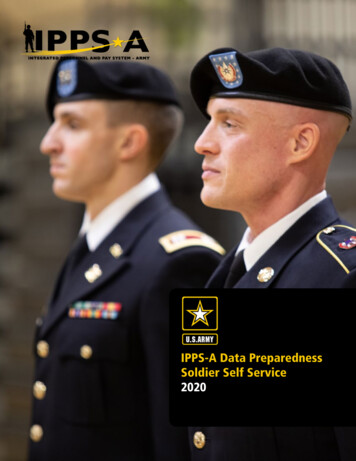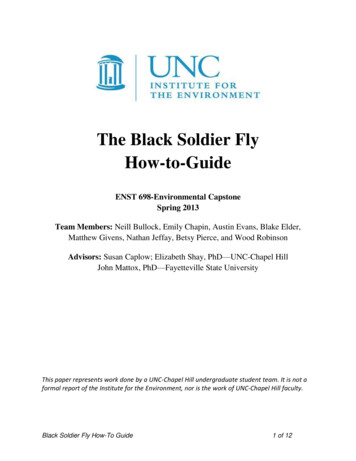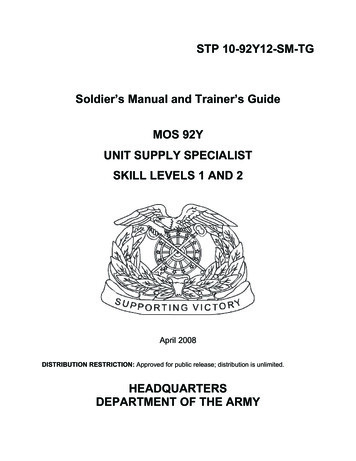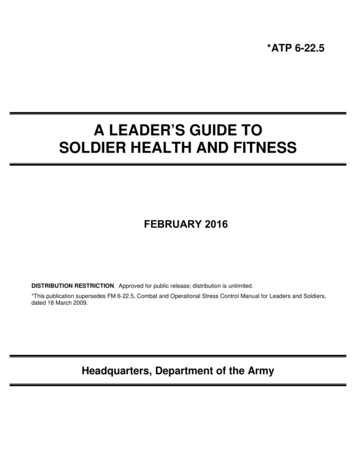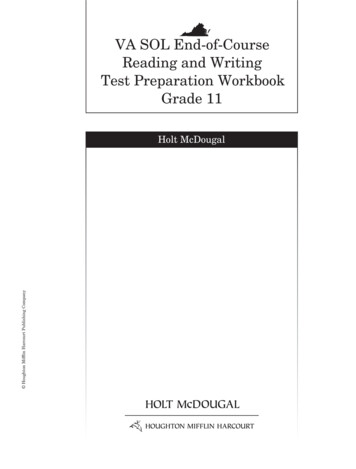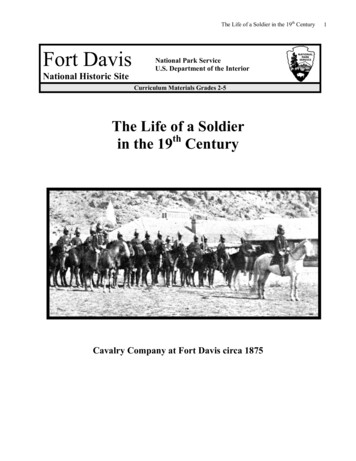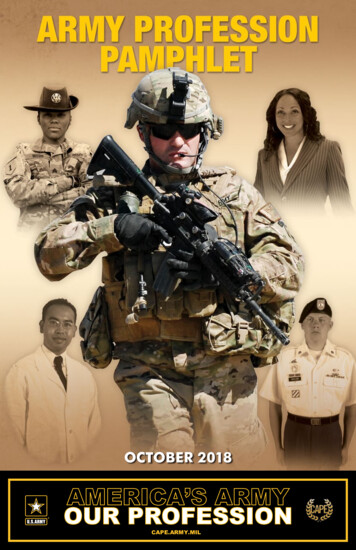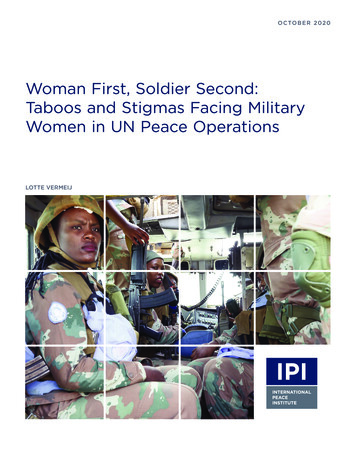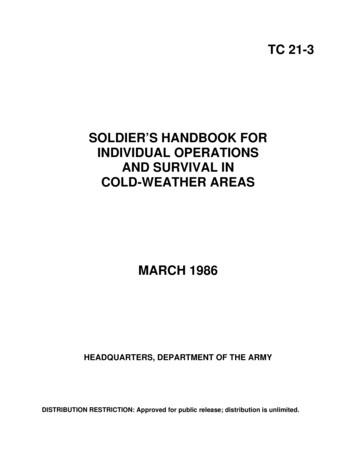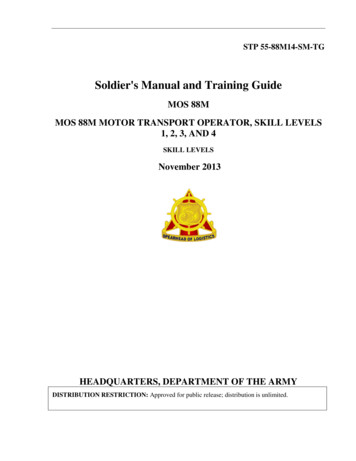
Transcription
STP 55-88M14-SM-TGSoldier's Manual and Training GuideMOS 88MMOS 88M MOTOR TRANSPORT OPERATOR, SKILL LEVELS1, 2, 3, AND 4SKILL LEVELSNovember 2013HEADQUARTERS, DEPARTMENT OF THE ARMYDISTRIBUTION RESTRICTION: Approved for public release; distribution is unlimited.
This publication is available at Army Knowledge .html).To receive publishing updates, please subscribe athttp://www.apd.army.mil/AdminPubs/new subscribe.asp.
STP 55-88M14-SM-TGSOLDIER TRAININGPUBLICATIONSTP 55-88M14-SM-TG*HEADQUARTERSDEPARTMENT OF THE ARMYWashington, DC, 21 November 2013Soldier's Manual and Training GuideMOS 88MMOS 88M MOTOR TRANSPORT OPERATOR, SKILL LEVELS1, 2, 3, AND 4SKILL LEVELS SL1, SL2, SL3, and SL4TABLE OF CONTENTSPAGEPREFACE . iiiCHAPTER 1 . 1-1Introduction . 1-11.1 General . 1-11.2 Training Requirement . 1-11.3 Battle-Focused Training . 1-51.4 Task Summary Format . 1-61.5 Training Execution . 1-61.6 Training Assessment . 1-81.7 Training Support . 1-9CHAPTER 2 . 2-1Trainer’s Guide . 2-12.1 General . 2-12-2. Part One, Section I. Subject Area Codes. . 2-32-3. Part One, Section II, Duty Position Training Requirements. . 2-42-4. Part Two, Critical Tasks List. 2-5CHAPTER 3 . 3-1MOS/Skill Level Tasks . 3-1Skill Level SL1 . 3-1Subject Area 1: Accident Forms and Reporting . 3-1Subject Area 2: Motor Vehicle Operator Maintenance . 3-4Subject Area 3: Motor Vehicle Operations . 3-13Subject Area 4: Transportation of Cargo . 3-103Subject Area 5: Adverse Terrain/Weather Operations . 3-128Subject Area 6: Convoy Planning and Operation . 3-133Subject Area 7: Convoy Execution/Defense . 3-139Subject Area 8: Hazardous Cargo Transportation . 3-167Subject Area 9: HEMTT-LHS/PLS Operations . 3-172DISTRIBUTION RESTRICTION: Approved for public release; distribution is unlimited.*This publication supersedes STP 55-88M14-SM-TG, 19 May 2009.21 November 2013Appendix i
STP 55-88M14-SM-TGSkill Level SL2 .3-225Subject Area 10: Motor Transport Supervision .3-225Subject Area 11: Convoy Execution/Defense .3-230Subject Area 12: Heavy Equipment Transport (HET) Operations . 3-238Subject Area 13: Motor Vehicle Operations .3-261Subject Area 14: Adverse Terrain/Weather Operations .3-266Subject Area 15: Transportation of Cargo .3-271Subject Area 16: Hazardous Cargo Transportation .3-276Skill Level SL3 .3-282Subject Area 17: Accident Forms and Reporting .3-282Subject Area 18: Motor Vehicle Operator Maintenance .3-284Subject Area 19: Motor Transport Supervision .3-289Subject Area 20: Convoy Execution/Defense .3-292Subject Area 21: Motor Pool Management.3-319Subject Area 22: Convoy Planning and Operation.3-331Subject Area 23: Hazardous Cargo Transportation .3-342Subject Area 24: Heavy Equipment Transport (HET) Operations . 3-345Skill Level SL4 .3-350Subject Area 25: Motor Pool Management.3-350Subject Area 26: Convoy Planning and Operation.3-357Subject Area 27: Motor Transport Management .3-364Subject Area 28: Logistics Automated Systems .3-377CHAPTER 4.3-1Duty Position Tasks .3-1APPENDIX A . A-1Appendix A DA Form 5164 . A-1APPENDIX B . B-1Appendix B DA Form 5165 . B-1GLOSSARY . Glossary-AREFERENCES .References-1ii21 November 2013
STP 55-88M14-SM-TGPREFACEThis publication is for skill level soldiers holding military occupational specialty (MOS) MOS 88M andfor trainers and first-line supervisors. It contains standardized training objectives, in the form of tasksummaries, to train and evaluate soldiers on critical tasks that support unit missions during wartime.Trainers and first-line supervisors should ensure soldiers holding MOS/SL MOS 88M have access to thispublication.This publication applies to the Active Army, the Army National Guard (ARNG)/the Army NationalGuard of the United States (ARNGUS), and the United States Army Reserve (USAR).The proponent of this publication is HQ, TRADOC. Send comments and recommendations on DA Form2028 (Recommended Changes to Publications and Blank Forms) directly to Commander, CASCOMSCOE (ATCL-TDM), G-3 Training & Doctrine Development, CTDD, 2221 Adams Avenue, Fort Lee,VA 23801-2102.21 November 2013iii
This page intentionally left blank.
STP 55-88M14-SM-TGCHAPTER 1Introduction1.1 GeneralThe soldier training publication (STP) identifies the individual military occupational specialty (MOS)training requirements for soldiers in various specialties, for example, Another source of STP task data isthe General Dennis J. Reimer Training and Doctrine Digital Library athttp://www.adtdl.army.mil/atdls.htm. Commanders, trainers, and soldiers should use the STP to plan,conduct, and evaluate individual training in units. The STP is the primary MOS reference to support theself-development and training of every soldier in the unit. It is used with the Soldier’s Manual ofCommon Tasks, Army training and evaluation program (ARTEP) products, and ADRP 7-0, TrainingUnits and Developing Leaders, to establish effective training plans and programs that integrate soldier,leader, and collective tasks. This chapter explains how to use the STP in establishing an effectiveindividual training program. It includes doctrinal principles and implications outlined in ADRP 7-0.Based on these guidelines, commanders and unit trainers must tailor the information to meet therequirements for their specific unit.1.2 Training RequirementEvery soldier, noncommissioned officer (NCO), warrant officer, and officer has one primary mission —to be trained and ready to fight and win our nation's wars. Success in battle does not happen by accident;it is a direct result of tough, realistic, and challenging training.a.Operational Environment.(1) Commanders and leaders at all levels must conduct training with respect to a widevariety of operational missions across the full spectrum of operations. These operations may includecombined arms, joint, multinational, and interagency considerations, and span the entire breadth of terrainand environmental possibilities. Commanders must strive to set the daily training conditions as closely aspossible to those expected for actual operations.(2) The operational missions of the Army include not only war, but also military operationsother than war (MOOTW). Operations may be conducted as major combat operations, a small-scalecontingency, or a peacetime military engagement. Offensive and defensive operations normally dominatemilitary operations in war along with some small-scale contingencies. Stability operations and supportoperations dominate in MOOTW. Commanders at all echelons may combine different types ofoperations simultaneously and sequentially to accomplish missions in war and MOOTW. These missionsrequire training since future conflict will likely involve a mix of combat and MOOTW, oftenconcurrently. The range of possible missions complicates training. Army forces cannot train for everypossible mission; they train for war and prepare for specific missions as time and circumstances permit.(3) One type of MOOTW is the Chemical, Biological, Radiological, Nuclear, and HighYield Explosive (CBRNE) event. To assist commanders and leaders in training their units, CBERNErelated information is being included in AMEDD mission training plans (MTPs). Even though mostcollective tasks within an MTP may support a CBRNE event, the ones that will most directly be impactedare clearly indicated with a statement in the CONDITION that reads: "THIS TASK MAY BE USED TOSUPPORT A CBRNE EVENT." These collective tasks and any supporting individual tasks in thissoldier’s manual should be considered for training emphasis.(4) Our forces today use a train-alert-deploy sequence. We cannot count on the time oropportunity to correct or make up training deficiencies after deployment. Maintaining forces that are21 November 20131-1
STP 55-88M14-SM-TGready now, places increased emphasis on training and the priority of training. This concept is a key linkbetween operational and training doctrine.(5) Units train to be ready for war based on the requirements of a precise and specificmission. In the process they develop a foundation of combat skills that can be refined based on therequirements of the assigned mission. Upon alert, commanders assess and refine from this foundation ofskills. In the train-alert-deploy process, commanders use whatever time the alert cycle provides tocontinue refinement of mission-focused training. Training continues during time available between alertnotification and deployment, between deployment and employment, and even during employment as unitsadapt to the specific battlefield environment and assimilate combat replacements.b.How the Army Trains the Army.(1) Training is a team effort and the entire Army — Department of the Army, majorcommands (MACOMs), the institutional training base, units, the combat training centers (CTCs), eachindividual soldier, and the civilian workforce — has a role that contributes to force readiness.Department of the Army and MACOMs are responsible for resourcing the Army to train. TheInstitutional Army, including schools, training centers, and NCO academies, for example, train soldiersand leaders to take their place in units in the Army by teaching the doctrine and tactics, techniques, andprocedures (TTP). Units, leaders, and individuals train to standard on their assigned critical individualtasks. The unit trains first as an organic unit and then as an integrated component of a team. Before theunit can be trained to function as a team, each soldier must be trained to perform their individualsupporting tasks to standard. Operational deployments and major training opportunities, such as majortraining exercises, CTCs, and ARTEP evaluations provide rigorous, realistic, and stressful training andoperational experience under actual or simulated combat and operational conditions to enhance unitreadiness and produce bold, innovative leaders. The result of this Army-wide team effort is a training andleader development system that is unrivaled in the world. Effective training produces the force —soldiers, leaders, and units — that can successfully execute any assigned mission.(2) The Army Training and Leader Development Model (Figure 1-1) centers on developingtrained and ready units led by competent and confident leaders. The model depicts an important dynamicthat creates a lifelong learning process. The three core domains that shape the critical learningexperiences throughout a soldier’s and leader’s time span are the operational, institutional, and selfdevelopment domains. Together, these domains interact using feedback and assessment from varioussources and methods to maximize warfighting readiness. Each domain has specific, measurable actionsthat must occur to develop our leaders. The operational domain includes home station training, CTC rotations, and joint trainingexercises and deployments that satisfy national objectives. Each of these actionsprovides foundational experiences for soldier, leader, and unit development. The institutional domain focuses on educating and training soldiers and leaders on thekey knowledge, skills, and attributes required to operate in any environment. It includesindividual, unit and joint schools, and advanced education. The self-development domain, both structured and informal, focuses on taking thoseactions necessary to reduce or eliminate the gap between operational and institutionalexperiences.1-221 November 2013
STP 55-88M14-SM-TGFigure 1-1. Army Training and Leader Development Model(3) Throughout this lifelong learning and experience process, there is formal and informalassessment and feedback of performance to prepare leaders and soldiers for their next level ofresponsibility. Assessment is the method used to determine the proficiency and potential of leadersagainst a known standard. Feedback must be clear, formative guidance directly related to the outcome oftraining events measured against standards.c.Leader Training and Leader Development.(1) Competent and confident leaders are a prerequisite to the successful training of units. Itis important to understand that leader training and leader development are integral parts of unit readiness.Leaders are inherently soldiers first and should be technically and tactically proficient in basic soldierskills. They are also adaptive, capable of sensing their environment, adjusting the plan when appropriate,and properly applying the proficiency acquired through training.(2) Leader training is an expansion of these skills that qualifies them to lead other soldiers.As such, doctrine and principles of training require the same level of attention of senior commanders.Leader training occurs in the Institutional Army, the unit, the CTCs, and through self-development.Leader training is just one portion of leader development.(3) Leader development is the deliberate, continuous, sequential, and progressive process,grounded in Army values, that grows soldiers and civilians into competent and confident leaders capableof decisive action. Leader development is achieved through the life-long synthesis of the knowledge,skills, and experiences gained through institutional training and education, organizational training,operational experience, and self-development. Commanders play the key roll in leader development thatideally produces tactically and technically competent, confident, and adaptive leaders who act withboldness and initiative in dynamic, complex situations to execute mission-type orders achieving thecommander’s intent.(4) A life cycle management diagram for soldiers is on page 1-5. You can find moreinformation and check for updates at http://das.cs.amedd.army.mil/ooc.htm (scroll down to LIFE CYCLEMANAGEMENT, select ENLISTED, and find the appropriate tab along the bottom). This information,combined with the MOS Training Plan in Chapter 2, forms the career development model for the MOS.21 November 20131-3
STP 55-88M14-SM-TGd. Training Responsibility. Soldier and leader training and development continue in the unit.Using the institutional foundation, training in organizations and units focuses and hones individual andteam skills and knowledge.(1)Commander Responsibility.(a) The unit commander is responsible for the wartime readiness of all elements inthe formation. The commander is, therefore, the primary trainer of the organization and is responsible forensuring that all training is conducted in accordance with the STP to the Army standard.(b) Commanders ensure STP standards are met during all training. If a soldier fails tomeet established standards for identified MOS tasks, the soldier must retrain until the tasks are performedto standard. Training to standard on MOS tasks is more important than completion of a unit trainingevent such as an ARTEP evaluation. The objective is to focus on sustaining MOS proficiency — this isthe critical factor commanders must adhere to when training individual soldiers in units.(2)NCO Responsibility.(a) A great strength of the US Army is its professional NCO Corps who takes pride inbeing responsible for the individual training of soldiers, crews, and small teams. The NCO supportchannel parallels and complements the chain of command. It is a channel of communication andsupervision from the Command Sergeant Major (CSM) to the First Sergeants (1SGs) and then to otherNCOs and enlisted personnel. NCOs train soldiers to the non-negotiable standards published in STPs.Commanders delegate authority to NCOs in the support channel as the primary trainers of individual,crew, and small team training. Commanders hold NCOs responsible for conducting standards-based,performance-oriented, battle-focused training and providing feedback on individual, crew, and teamproficiency. Commanders define responsibilities and authority of their NCOs to their staffs andsubordinates.(b) NCOs continue the Soldierization process of newly assigned enlisted soldiers, andbegin their professional development. NCOs are responsible for conducting standards-based,performance-oriented, battle-focused training. They identify specific individual, crew, and small teamtasks that support the unit’s collective mission essential tasks; plan, prepare, rehearse, and executetraining; and evaluate training and conduct after action reviews (AARs) to provide feedback to thecommander on individual, crew, and small team proficiency. Senior NCOs coach junior NCOs to mastera wide range of individual tasks.(3) Soldier Responsibility. Each soldier is responsible for performing individual tasksidentified by the first-line supervisor based on the unit’s mission essential task list (METL). Soldiersmust perform tasks to the standards included in the task summary. If soldiers have questions about tasksor which tasks in this manual they must perform, they are responsible for asking their first-line supervisorfor clarification, assistance, and guidance. First-line supervisors know how to perform each task or candirect soldiers to appropriate training materials, including current field manuals, technical manuals, andArmy regulations. Soldiers are responsible for using these materials to maintain performance. They arealso responsible for maintaining standard performance levels of all Soldier's Manual of Common Tasks attheir current skill level and below. Periodically, soldiers should ask their supervisor or another soldier tocheck their performance to ensure that they can perform the tasks.1-421 November 2013
STP 55-88M14-SM-TG1.3 Battle-Focused TrainingBattle focus is a concept used to derive peacetime training requirements from assigned and anticipatedmissions. The priority of training in units is to train to standard on the wartime mission. Battle focusguides the planning, preparation, execution, and assessment of each organization's training program toensure its members train as they are going to fight. Battle focus is critical throughout the entire trainingprocess and is used by commanders to allocate resources for training based on wartime and operationalmission requirements. Battle focus enables commanders and staffs at all echelons to structure a trainingprogram that copes with non-mission-related requirements while focusing on mission essential trainingactivities. It is recognized that a unit cannot attain proficiency to standard on every task whether due totime or other resource constraints. However, unit commanders can achieve a successful training programby consciously focusing on a reduced number of METL tasks that are essential to missionaccomplishment.a. Linkage Between METL and STP. A critical aspect of the battle focus concept is tounderstand the responsibility for and the linkage between the collective mission essential tasks and theindividual tasks that support them. For example, the commander and the CSM/1SG must jointlycoordinate the collective mission essential tasks and supporting individual tasks on which the unit willconcentrate its efforts during a given period. This task hierarchy is provided in the task database at theReimer Digital Library. The CSM/1SG must select the specific individual tasks that support eachcollective task to be trained. Although NCOs have the primary role in training and sustaining individualsoldier skills, officers at every echelon remain responsible for training to established standards duringboth individual and collective training. Battle focus is applied to all missions across the full spectrum ofoperations.b. Relationship of STPs to Battle-focused Training. The two key components of any STP are thesoldier's manual (SM) and trainer’s guide (TG). Each gives leaders important information to helpimplement the battle-focused training process. The trainer’s guide relates soldier and leader tasks in theMOS and skill level to duty positions and equipment. It states where the task is trained, how oftentraining should occur to sustain proficiency, and who in the unit should be trained. As leaders assess andplan training, they should rely on the trainer’s guide to help identify training needs.(1) Leaders conduct and evaluate training based on Army-wide training objectives and onthe task standards published in the soldier's manual task summaries or in the Reimer Digital Library. Thetask summaries ensure that - Trainers in every unit and location define task standards the same way Trainers evaluate all soldiers to the same standards(2)Figure 1-2 shows how battle-focused training relates to the trainer’s guide and soldier'smanual: The left column shows the steps involved in training soldiers. The right column shows how the STP supports each of these steps.BATTLE-FOCUS PROCESSSelect supporting soldier tasksConduct training assessmentDetermine training objectivesDetermine strategy; plan for trainingConduct pre-execution checksExecute training; conduct after action review21 November 2013STP SUPPORT PROCESSUse TG to relate tasks to METLUse TG to define what soldier tasks to assessUse TG to set objectivesUse TG to relate soldier tasks to strategyUse SM task summary as source for taskperformanceUse SM task summary as source for task1-5
STP 55-88M14-SM-TGEvaluate training against established standardsperformanceUse SM task summary as standard for evaluationFigure 1-2. Relationship of Battle-focused Training and STP1.4 Task Summary FormatTask summaries outline the wartime performance requirements of each critical task in the SM. Theyprovide the soldier and the trainer with the information necessary to prepare, conduct, and evaluatecritical task training. As a minimum, task summaries include information the soldier must know and theskills that he must perform to standards for each task. The format of the task summaries included in thisSM is as follows:a.Task Title. The task title identifies the action to be performed.b. Task Number. A 10-digit number identifies each task or skill. This task number, along withthe task title, must be included in any correspondence pertaining to the task.c. Conditions. The task conditions identify all the equipment, tools, references, job aids, andsupporting personnel that the soldier needs to use to perform the task in wartime. This section identifiesany environmental conditions that can alter task performance, such as visibility, temperature, or wind.This section also identifies any specific cues or events that trigger task performance, such as a chemicalattack or identification of a threat vehicle.d. Standards. The task standards describe how well and to what level the task must be performedunder wartime conditions. Standards are typically described in terms of accuracy, completeness, andspeed.e. Performance Steps. This section includes a detailed outline of information on how to performthe task. Additionally, some task summaries include safety statements and notes. Safety statements(danger, warning, and caution) alert users to the possibility of immediate death, personal injury, ordamage to equipment. Notes provide a small, extra supportive explanation or hint relative to theperformance steps.f. Evaluation Preparation (when used). This subsection indicates necessary modifications to taskperformance in order to train and evaluate a task that cannot be trained to the wartime standard underwartime conditions. It may also include special training and evaluation preparation instructions toaccommodate these modifications and any instructions that should be given to the soldier beforeevaluation.g. Performance Measures. This evaluation guide identifies the specific actions that the soldiermust do to successfully complete the task. These actions are listed in a GO/NO-GO format for easyevaluation. Each evaluation guide contains an evaluation guidance statement that indicates therequirements for receiving a GO on the evaluation.h. References. This section identifies references that provide more detailed and thoroughexplanations of task performance requirements than those given in the task summary description.1.5 Training Execution1-621 November 2013
STP 55-88M14-SM-TGAll good training, regardless of the specific collective, leader, and individual tasks being executed, mustcomply with certain common requirements. These include adequate preparation, effective presentationand practice, and thorough evaluation. The execution of training includes preparation for training,conduct of training, and recovery from training.a. Preparation for Training. Formal near-term planning for training culminates with thepublication of the unit training schedule. Informal planning, detailed coordination, and preparation forexecuting the training continue until the training is performed. Commanders and other trainers usetraining meetings to assign responsibility for preparation of all scheduled training. Preparation fortraining includes selecting tasks to be trained, planning the conduct of the training, training the trainers,reconnaissance of the site, issuing the training execution plan, and conducting rehearsals and preexecution checks. Pre-execution checks are preliminary actions commanders and trainers use to identifyresponsibility for these and other
self-development and training of every soldier in the unit. It is used with the Soldier’s Manual of Common Tasks, Army training and evaluation program (ARTEP) products, and ADRP 7-0, Training Units and Developing Leaders, to establish effective training plans and progr

